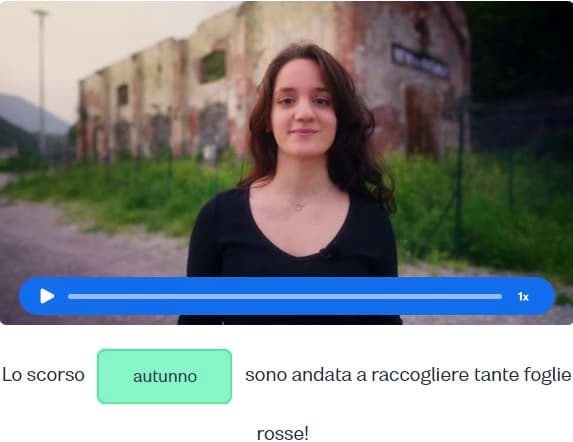I want to learn...
Ciao! Have you ever dreamt of your perfect Italian holiday?
Imagine yourself wandering in an open-air market in a sunny town in Italy, finding a lovely hat or a colorful fruit that you want to try. Wouldn’t it be great to be able to communicate and describe the thing that you want, rather than just pointing at it? In order to do that, a set of words that you really need to master is colors!
Knowing colors in Italian will help you when you need to describe things, improving your communication skills in practical contexts and enabling you to successfully carry out day-to-day tasks. Plus, Italian is the language of fashion and food, so colors are an essential part of it!
In this article, you will learn how to say the main colors in Italian, and a few grammar tips about their use.
How do you say “color” in Italian?
First things first: let’s learn the word for “color”!
Like all romance languages, Italian has a system of grammatical gender, meaning that nouns have an arbitrary “gender” assigned to them - in Italian it’s either masculine or feminine.
The word for “color” is almost identical to the English one: “colore”, and it’s pronounced “co-LO-ray”. it’s masculine, so it’s accompanied by masculine articles “il” (“the”) or “un” (“a”). The plural form is “colori” and it’s pronounced “co-LO-ree”.
Here are a few examples:
Mi piace il colore rosso. - I like the color red.
Il rosso è un colore caldo. - Red is a warm color.
Non amo i colori scuri. - I am not fond of dark colors.
Do you need a refresher on the Italian alphabet and pronunciation? Check out our
Colors used as nouns
In Italian, the form that the words for colors take depends on their function in the sentence. As we’ve seen in the examples above, you can use these words to identify the colors themselves. In this case, they are nouns and need to be preceded by the correct masculine definite article:
Il rosso - red.
L’arancione - orange.
Il giallo - yellow.
Il rosa - pink.
Il blu - blue.
L’azzurro - light blue.
Il viola - purple.
Il verde - green.
Il marrone - brown.
Il grigio - gray.
Il bianco - white.
Il nero - black.
These are not all the Italian colors, but they are the most common ones, so it’s a good start!
Here are a few examples of colors used as nouns:
Il verde è il mio colore preferito. - Green is my favorite color.
Per me, il blu è un colore rilassante. - For me, blue is a relaxing color.
Il bianco è un colore neutro. - White is a neutral color.
Colors used as adjectives
When you use colors to describe objects or other things, they take the function of adjectives in the sentence, or “describing words”. In this case, they have different forms, and their gender and number must change to follow the gender and number of the word they refer to.
It sounds more difficult than it is!
Check out these examples:
La casa è bianca, il gatto è bianco. - The house is white, the cat is white. (“casa” is feminine, “gatto” is masculine).
Il libro è verde, i calzini sono verdi. - The book is green, the socks are green (“libro” is singular, “calzini” is plural).
Gli stivali sono neri, le scarpe sono nere. - The boots are black, the shoes are black (“stivali” is masculine plural, “scarpe” is feminine plural).
Colors ending in -o
When they are used in this way, colors follow the general usage rules of Italian adjectives. The ones that have the base form in -o, like “bianco”, “rosso” and “nero”, change their ending to “-a” in the feminine, to “i” in the masculine plural, and to “e” in the feminine plural.
In the table below you will find all the possible forms of these colors:
Table of Italian colors ending in -o and their forms
| Masculine singular | Masculine plural | Feminine singular | Feminine plural | Translation |
|---|---|---|---|---|
| rosso | rossi | rossa | rosse | red |
| giallo | gialli | gialla | gialle | yellow |
| azzurro | azzurri | azzurra | azzurre | light blue |
| grigio | grigi | grigia | grigie | gray |
| bianco | bianchi | bianca | bianche | white |
| nero | neri | nera | nere | black |
When using these, you will need to pick masculine singular forms to describe masculine singular nouns, feminine singular forms to describe feminine plural nouns, and so on:
Ho un maglione nero e una bicicletta grigia. - I have a black sweater and a gray bicycle.
Le case sono grigie, ma i tetti sono rossi. - The houses are gray, but the roofs are red.
Vedo il cielo azzurro con le nuvole bianche. - I can see the blue sky with white clouds.
Colors ending in -e
You use the form in -e for all singular words, and the form in -i for all plural words, like in these examples:
Il cappello è arancione e la tazza è arancione. - The hat is orange and the mug is orange.
I cappelli sono arancioni e le tazze sono arancioni. - The hats are orange and the mugs are orange.
Table of Italian colors ending in -e and their forms
| Masculine and feminine singular | Masculine and feminine plural | Translation |
|---|---|---|
| arancione | arancioni | orange |
| verde | verdi | green |
| marrone | marroni | brown |
Unchangeable colors
Finally, some colors make an exception to the rule, and do not change to follow the gender and number of the noun they refer to. These colors are unchangeable and regardless of the word they refer to, they only have one form:
Table of unchangeable colors
| Italian | English |
|---|---|
| rosa | pink |
| blu | blue |
| viola | purple |
These are easy: use the same form for any word, regardless of the gender and number!
Check out these examples:
Il maglione e blu e la sciarpa è blu. - The sweater is blue and the scarf is blue.
I maglioni sono blu e le sciarpe sono blu. - The sweaters are blue and the scarves are blue.
How do we say “colorful” in Italian?
Finally, it might be handy to be able to say that something has a lot of colors, even without specifying which ones. The word you’re looking for here is “colorato/a” and it is also an adjective, so it changes according to the noun it describes:
Vorrei comprare un vestito colorato. - I would like to buy a colorful dress.<br.
I muri delle case sono colorati. - The houses’ walls are colorful.<br.
Quel negozio ha una vetrina molto colorata. - That shop has a very colorful window.
This is a useful word - so many things in Italy arecolorate!
Placement of colors in a sentence
Knowing where to place colors in a sentence is very important to use these words correctly. In Italian colors, like other adjectives, normally comeafterthe noun they refer to.
Check out the examples:
Carlo ha gli occhi azzurri e i capelli neri. - Carlo has blue eyes and black hair.
Il cane nero è più veloce del cane bianco. - The black dog is faster than the white dog.
A bit of culture: The Italian flag
You've probably seen the Italian flag many times and know that its colors are verde, bianco and rosso (you understand that now!). The Italians call it “il tricolore” (the tricolor flag). Have you ever wondered what the meaning of the colors on the Italian flag is?
There are historical reasons for the use of these colors. They were part of the flags of the older states that came to form the Kingdom of Italy. But there are symbolic reasons as well: red symbolizes the blood shed by many to achieve unification, white represents the Catholic faith of many Italians, and green is the color of hope that led many Italians to fight for a free and unified country. Now you know why there is a close connection between the colors of the Italian flag, and Italian history and culture!
Italian colors: Wrapping up
Benissimo! You've learned how to say the main colors in Italian, and how to use them in context, depending on their function in a sentence. Thanks to this important addition to your vocabulary, you'll be able to describe things such as objects, people, and places, and talk about them using specific terms, in many different contexts. That's great!
AUTHOR

Chiara Pegoraro
Newlanguages


